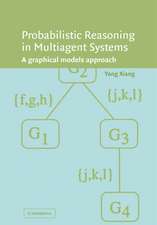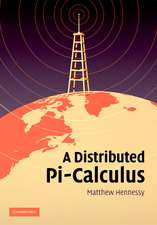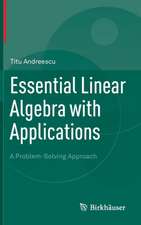Mathematics of Discrete Structures for Computer Science
Autor Gordon J. Paceen Limba Engleză Hardback – 9 sep 2012
The common approach to presenting mathematical concepts and operators is to define them in terms of properties they satisfy, and then based on these definitions develop ways of computing the result of applying the operators and prove them correct. This book is mainly written for computer science students, so here the author takes a different approach: he starts by defining ways of calculating the results of applying the operators and then proves that they satisfy various properties. After justifying his underlying approach the author offers detailed chapters covering propositional logic, predicate calculus, sets, relations, discrete structures, structured types, numbers, and reasoning about programs.
The book contains chapter and section summaries, detailed proofs and many end-of-section exercises -- key to the learning process. The book is suitable for undergraduate and graduate students, and although the treatment focuses on areas with frequent applications in computer science, the book is also suitable for students of mathematics and engineering.
| Toate formatele și edițiile | Preț | Express |
|---|---|---|
| Paperback (1) | 333.22 lei 6-8 săpt. | |
| Springer Berlin, Heidelberg – 15 oct 2014 | 333.22 lei 6-8 săpt. | |
| Hardback (1) | 506.97 lei 6-8 săpt. | |
| Springer Berlin, Heidelberg – 9 sep 2012 | 506.97 lei 6-8 săpt. |
Preț: 506.97 lei
Preț vechi: 633.72 lei
-20% Nou
Puncte Express: 760
Preț estimativ în valută:
97.02€ • 100.92$ • 80.10£
97.02€ • 100.92$ • 80.10£
Carte tipărită la comandă
Livrare economică 14-28 aprilie
Preluare comenzi: 021 569.72.76
Specificații
ISBN-13: 9783642298394
ISBN-10: 3642298397
Pagini: 312
Ilustrații: XVI, 296 p.
Dimensiuni: 155 x 235 x 25 mm
Greutate: 0.52 kg
Ediția:2012
Editura: Springer Berlin, Heidelberg
Colecția Springer
Locul publicării:Berlin, Heidelberg, Germany
ISBN-10: 3642298397
Pagini: 312
Ilustrații: XVI, 296 p.
Dimensiuni: 155 x 235 x 25 mm
Greutate: 0.52 kg
Ediția:2012
Editura: Springer Berlin, Heidelberg
Colecția Springer
Locul publicării:Berlin, Heidelberg, Germany
Public țintă
GraduateCuprins
Why Mathematics?.- Propositional Logic.- Predicate Calculus.- Sets.- Relations.- Classifying Relations.- More Discrete Structures.- Defining New Structured Types.- Numbers.- Reasoning About Programs.- Index.
Recenzii
From the reviews:
"Pace’s Mathematics of Discrete Structures for Computer Science is a delightful book, written to be read and enjoyed as it moves from justifying the central place of maths in computing, through the usual set theory and logic, on to numbers, types and the halting problem." [Harold Thimbleby, Times Higher Education Supplement, 06/13]
“Discrete mathematics is as essential for computer science as calculus is for physics. … this book by Pace (Univ. of Malta) focuses on topics which are central to computer science, including the formal definition of data types and the use of induction to prove correctness. … is most useful for future courses in programming languages, particularly those that use a language like Haskell. The book includes many helpful worked examples. Summing Up: Recommended. Lower-division undergraduates through researchers/faculty.” [P. Cull, Choice, Vol. 50 (8), April, 2013]
“There is no doubt that discrete mathematics is a mandatory component of any good computer science program. Therefore, a textbook for this area is always very useful. … this book particularly emphasizes the difference between the algorithmic and the descriptive approach. … topics are well presented and can be used immediately for teaching such a course. It is also very helpful that many exercises are included into the text and support the learning process.” [Christian Posthoff, Zentralblatt MATH, Vol. 1254, 2013]
“The overwhelming majority of the subjects is discussed from an algorithmic viewpoint, considering how we could use this or that result while writing code for a computer. … you want to teach a course focusing on how to use discrete structures in computer science, then the book is a concise, low-cost alternative to textbooks in discrete mathematics.” (Miklós Bóna, MAA Reviews, December, 2012)
“The standard topics--including propositional logic, predicate calculus, sets,relations, discrete structures, defining new structured types, numbers, and reasoning about programs--are covered … . As such, the book is suitable for students who understand algebra and can program. … Teachers who use this text have noted how enthusiastically their students discuss its ideas in class. … Overall, the book is well made.” [Richard Botting, ACM Computing Reviews, December, 2012]
"Profound knowledge and skills in discrete mathematics are mandatory for a well educated computer scientist. Therefore a corresponding curriculum typically requires at least a basic course on this subject. This textbook, which is based on the lectures given by the author at the University of Malta, is a perfect companion for every student taking such a course. ... Besides a thorough formal presentation the book always gives a convincing motivation for studying the corresponding structures and explains the main ideas using illustrations. A well chosen set of exercises rounds off each topic. After studying the presented material a computer science student will be well prepared for further, more specialized courses." [Martin Leucker, Lübeck]
"Pace’s Mathematics of Discrete Structures for Computer Science is a delightful book, written to be read and enjoyed as it moves from justifying the central place of maths in computing, through the usual set theory and logic, on to numbers, types and the halting problem." [Harold Thimbleby, Times Higher Education Supplement, 06/13]
“Discrete mathematics is as essential for computer science as calculus is for physics. … this book by Pace (Univ. of Malta) focuses on topics which are central to computer science, including the formal definition of data types and the use of induction to prove correctness. … is most useful for future courses in programming languages, particularly those that use a language like Haskell. The book includes many helpful worked examples. Summing Up: Recommended. Lower-division undergraduates through researchers/faculty.” [P. Cull, Choice, Vol. 50 (8), April, 2013]
“There is no doubt that discrete mathematics is a mandatory component of any good computer science program. Therefore, a textbook for this area is always very useful. … this book particularly emphasizes the difference between the algorithmic and the descriptive approach. … topics are well presented and can be used immediately for teaching such a course. It is also very helpful that many exercises are included into the text and support the learning process.” [Christian Posthoff, Zentralblatt MATH, Vol. 1254, 2013]
“The overwhelming majority of the subjects is discussed from an algorithmic viewpoint, considering how we could use this or that result while writing code for a computer. … you want to teach a course focusing on how to use discrete structures in computer science, then the book is a concise, low-cost alternative to textbooks in discrete mathematics.” (Miklós Bóna, MAA Reviews, December, 2012)
“The standard topics--including propositional logic, predicate calculus, sets,relations, discrete structures, defining new structured types, numbers, and reasoning about programs--are covered … . As such, the book is suitable for students who understand algebra and can program. … Teachers who use this text have noted how enthusiastically their students discuss its ideas in class. … Overall, the book is well made.” [Richard Botting, ACM Computing Reviews, December, 2012]
"Profound knowledge and skills in discrete mathematics are mandatory for a well educated computer scientist. Therefore a corresponding curriculum typically requires at least a basic course on this subject. This textbook, which is based on the lectures given by the author at the University of Malta, is a perfect companion for every student taking such a course. ... Besides a thorough formal presentation the book always gives a convincing motivation for studying the corresponding structures and explains the main ideas using illustrations. A well chosen set of exercises rounds off each topic. After studying the presented material a computer science student will be well prepared for further, more specialized courses." [Martin Leucker, Lübeck]
Notă biografică
Gordon J. Pace is an associate professor in the Department of Computer Science of the University of Malta. He has an M.Sc. and a D.Phil. from Oxford, where he was a Rhodes Scholar. He has considerable experience teaching courses on the topic of his book to undergraduates in Computer Science, Mathematics and Engineering. His research interests include formal methods for software and hardware, runtime verification and formal analysis of contracts.
Textul de pe ultima copertă
Mathematics plays a key role in computer science, some researchers would consider computers as nothing but the physical embodiment of mathematical systems. And whether you are designing a digital circuit, a computer program or a new programming language, you need mathematics to be able to reason about the design -- its correctness, robustness and dependability. This book covers the foundational mathematics necessary for courses in computer science.
The common approach to presenting mathematical concepts and operators is to define them in terms of properties they satisfy, and then based on these definitions develop ways of computing the result of applying the operators and prove them correct. This book is mainly written for computer science students, so here the author takes a different approach: he starts by defining ways of calculating the results of applying the operators and then proves that they satisfy various properties. After justifying his underlying approach the author offers detailed chapters covering propositional logic, predicate calculus, sets, relations, discrete structures, structured types, numbers, and reasoning about programs.
The book contains chapter and section summaries, detailed proofs and many end-of-section exercises -- key to the learning process. The book is suitable for undergraduate and graduate students, and although the treatment focuses on areas with frequent applications in computer science, the book is also suitable for students of mathematics and engineering.
The common approach to presenting mathematical concepts and operators is to define them in terms of properties they satisfy, and then based on these definitions develop ways of computing the result of applying the operators and prove them correct. This book is mainly written for computer science students, so here the author takes a different approach: he starts by defining ways of calculating the results of applying the operators and then proves that they satisfy various properties. After justifying his underlying approach the author offers detailed chapters covering propositional logic, predicate calculus, sets, relations, discrete structures, structured types, numbers, and reasoning about programs.
The book contains chapter and section summaries, detailed proofs and many end-of-section exercises -- key to the learning process. The book is suitable for undergraduate and graduate students, and although the treatment focuses on areas with frequent applications in computer science, the book is also suitable for students of mathematics and engineering.
Caracteristici
Author takes an unusual approach, starts by defining ways of calculating operators and then proves that they satisfy various properties Treatment is largely self-contained, and even students without prior advanced mathematics should be able to learn from the text Author has considerable experience teaching this course to undergraduate students Includes supplementary material: sn.pub/extras













